Creating natural walkways transforms outdoor spaces into functional and beautiful pathways that seamlessly blend with landscape environments. Natural materials offer durability, aesthetic appeal, and environmental benefits while providing safe passage through gardens, yards, and outdoor areas. From traditional stepping stones to innovative mixed-material designs, natural walkways enhance property value and create inviting outdoor experiences. These pathways guide movement, protect landscaping, and define outdoor spaces while maintaining harmony with surrounding vegetation. Whether seeking rustic charm or contemporary elegance, natural walkway materials provide endless design possibilities for every style preference and budget consideration.
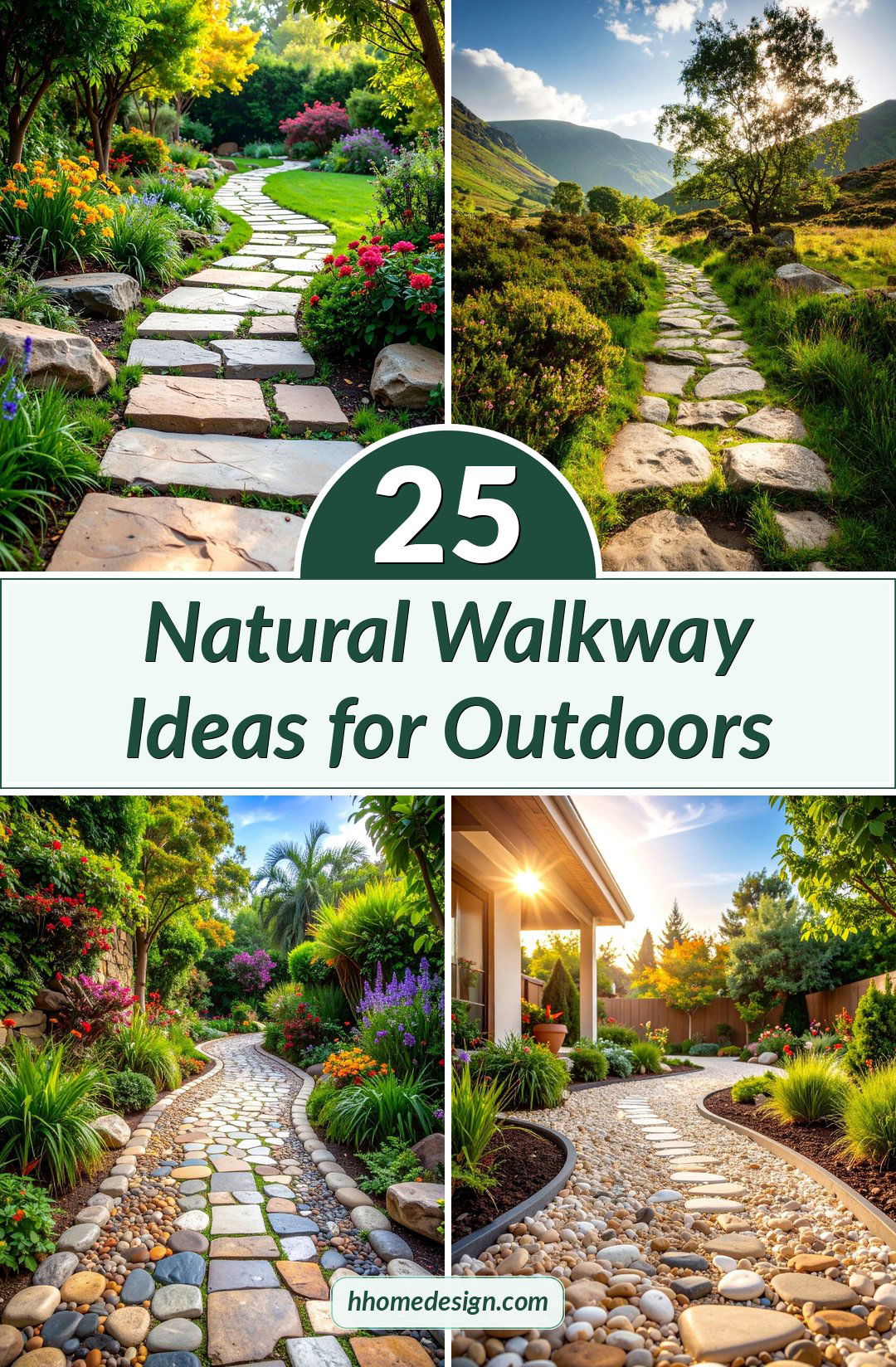
1. Limestone Stepping Stone Walkway
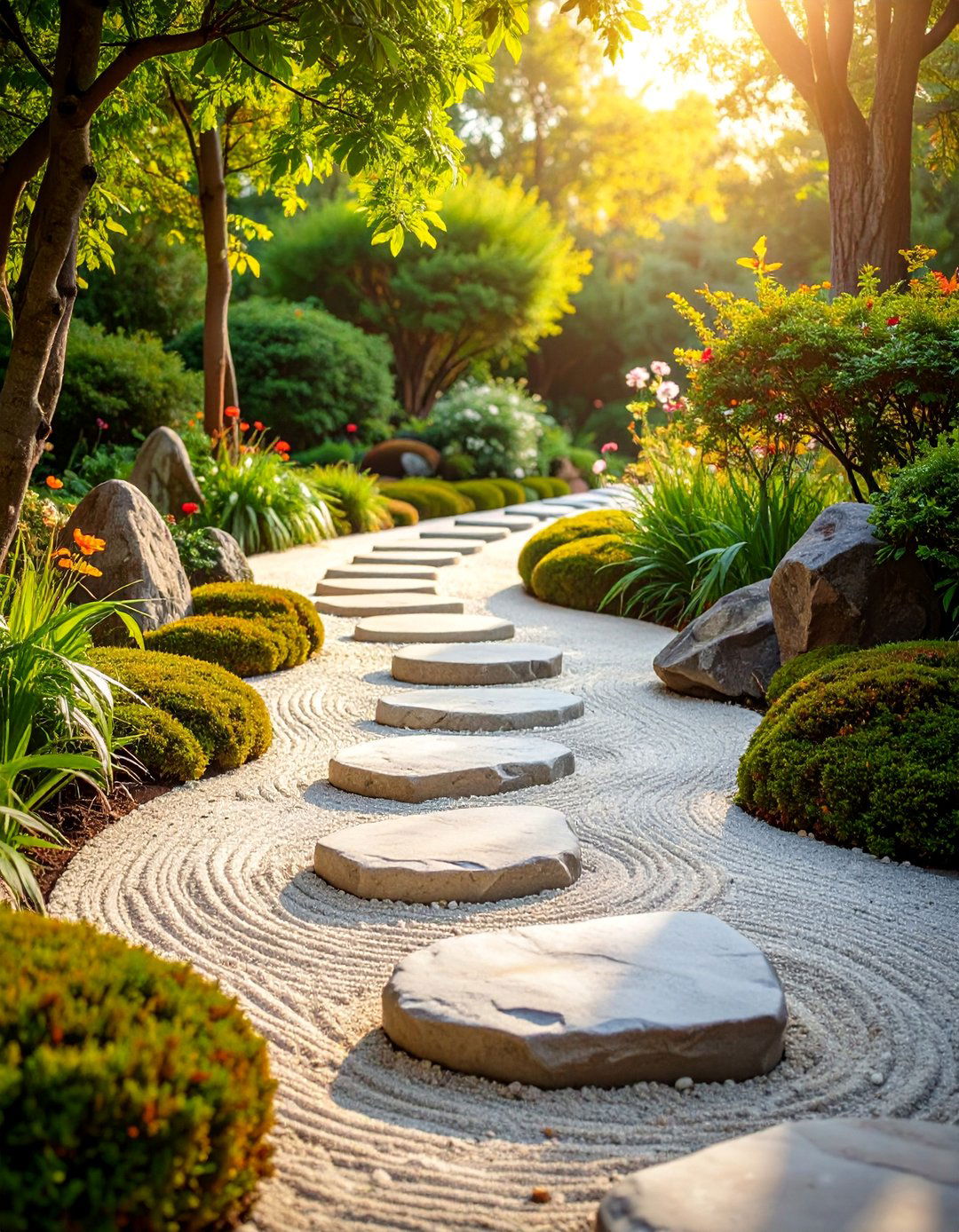
Limestone stepping stones create elegant pathways with naturally occurring textures and warm, neutral tones that complement any landscape style. These durable stones resist weathering while providing non-slip surfaces for safe walking. Individual limestone pieces can be cut into custom shapes or used in natural irregular forms for organic appeal. Installation involves placing stones on leveled sand bases with comfortable spacing for easy foot placement. Gaps between stones accommodate moss growth, decorative gravel, or ground cover plants for enhanced visual interest. The natural porosity of limestone allows proper drainage while the material ages beautifully over time, developing character and patina.
2. Pea Gravel Garden Path
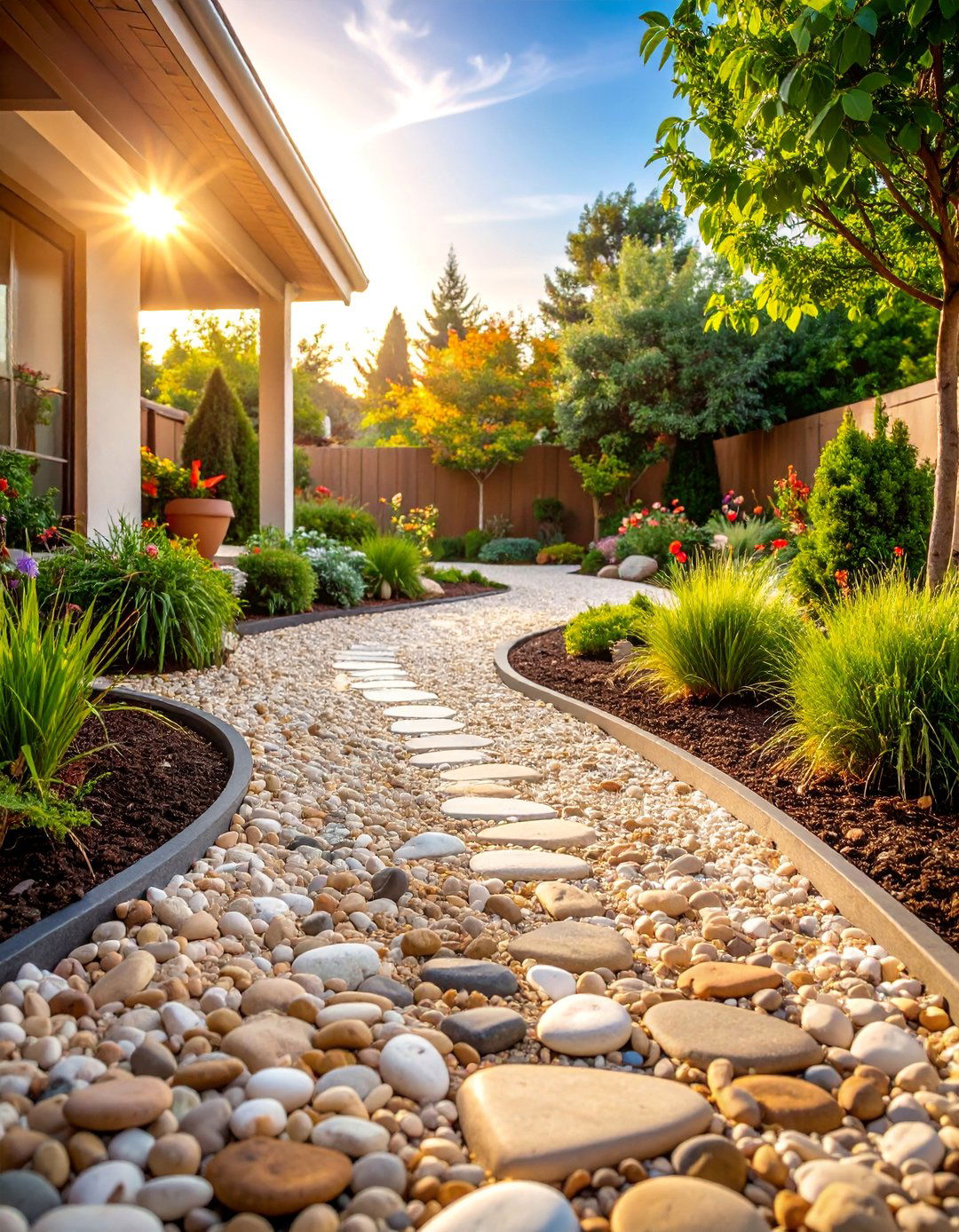
Pea gravel paths offer affordable, low-maintenance walkway solutions with excellent drainage properties and natural aesthetics. These small, rounded stones create comfortable walking surfaces while preventing water accumulation and mud formation. Installation requires landscape fabric underlayment and proper edging to contain gravel within designated pathways. Pea gravel comes in various earth-tone colors including gray, tan, and brown shades that harmonize with natural surroundings. Regular maintenance involves occasional raking to maintain smooth surfaces and periodic additions to replace scattered stones. The permeable nature supports sustainable landscaping practices while providing durable, all-weather accessibility through gardens and outdoor spaces.
3. Wood Chip Mulch Walkway

Wood chip mulch creates soft, natural pathways that decompose gradually while enriching surrounding soil and suppressing weed growth. This organic material provides cushioned walking surfaces ideal for garden paths and informal walkways. Installation involves clearing existing vegetation, applying landscape fabric, and spreading chips to appropriate depth for comfortable foot traffic. Regular replenishment maintains path integrity as organic matter breaks down naturally. Wood chips blend seamlessly with garden environments while supporting beneficial soil microorganisms and retaining moisture for nearby plants. Various chip sizes and wood types offer different textures and decomposition rates to suit specific landscape needs and aesthetic preferences.
4. Flagstone Natural Stone Path

Flagstone pathways showcase natural stone beauty with irregular shapes and rich color variations that create stunning landscape features. These flat, broad stones provide stable walking surfaces while maintaining organic, rustic appearances that complement traditional and contemporary designs. Natural flagstone installation allows creative arrangements with varied spacing for grass or groundcover integration. Multiple stone types including sandstone, limestone, and slate offer different colors, textures, and durability characteristics. Proper preparation with sand leveling ensures stable, long-lasting installations. Flagstone weathers gracefully over time, developing moss growth and patina that enhances natural charm while providing decades of reliable service in outdoor environments.
5. River Rock Stepping Path
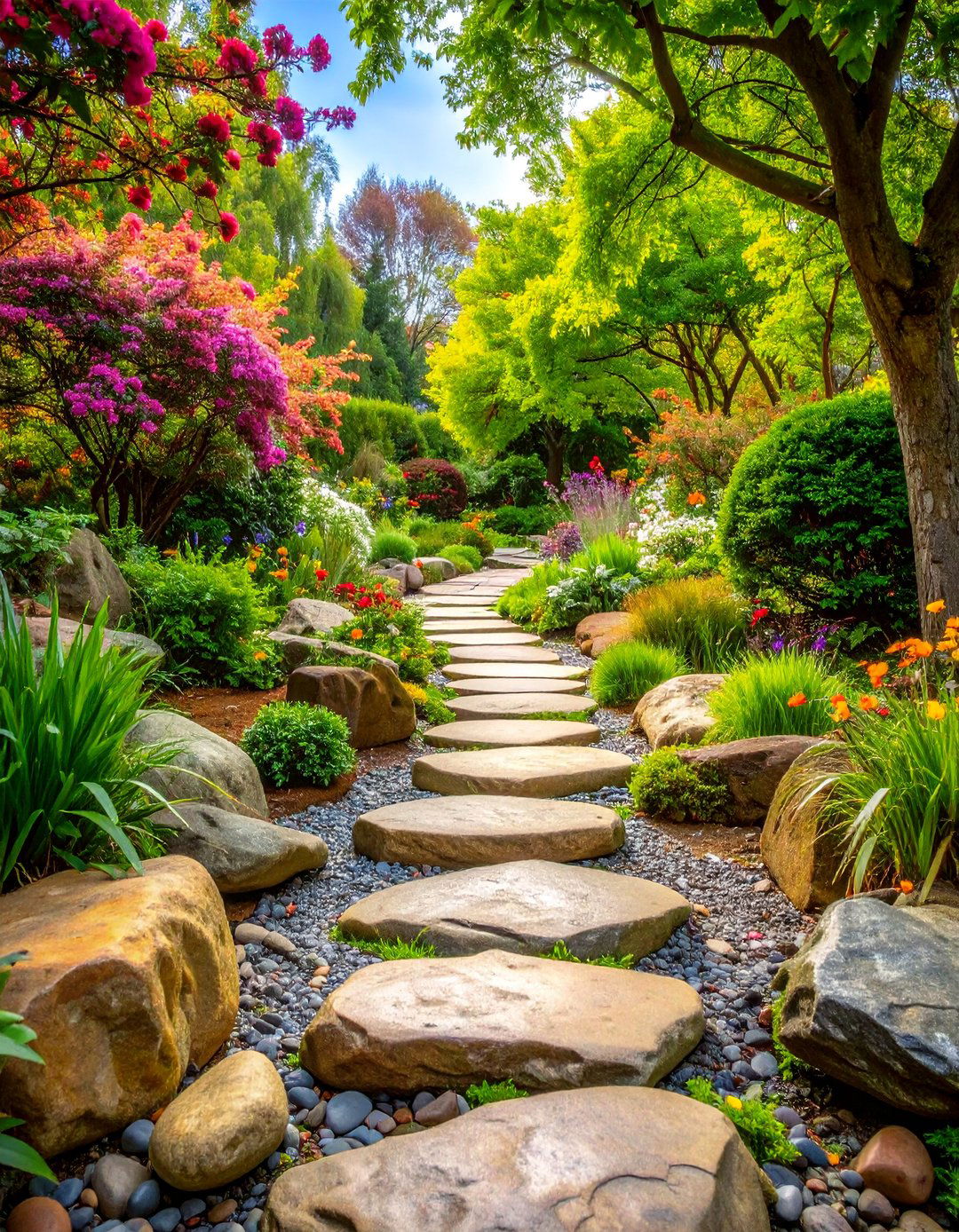
River rock paths utilize smooth, water-worn stones to create naturalistic walkways reminiscent of stream beds and natural watercourses. These rounded stones offer varied sizes and colors from subtle grays to warm earth tones that blend beautifully with landscape surroundings. Installation involves careful selection and placement of appropriately sized stones with stable, flat surfaces for safe walking. Smaller river rocks fill gaps between larger stepping stones, creating cohesive visual flow while providing excellent drainage. The smooth surfaces require occasional cleaning to prevent slippery conditions when wet. River rock paths work exceptionally well in naturalistic gardens, Japanese-inspired landscapes, and areas adjacent to water features.
6. Crushed Granite Walkway

Crushed granite walkways provide durable, permeable surfaces with sophisticated appearances that complement both formal and informal landscape designs. This decomposed granite material compacts well to create stable walking surfaces while maintaining natural aesthetics. Installation requires proper grade preparation and occasional moisture application during compaction to achieve optimal density. The fine texture allows comfortable barefoot walking while preventing dust issues common with other crushed materials. Various granite colors including gold, gray, and red offer design flexibility to coordinate with existing hardscape elements. Regular maintenance involves periodic raking and minor additions to maintain smooth surfaces and proper drainage characteristics.
7. Reclaimed Brick Pattern Path

Reclaimed brick pathways combine historical character with sustainable material choices to create timeless walkway designs with rich patina and weathered charm. These recycled materials offer environmental benefits while providing durable, slip-resistant surfaces suitable for heavy foot traffic. Traditional laying patterns including herringbone, basket weave, and running bond create distinct visual effects that complement various architectural styles. Proper sand base preparation ensures stable installation while allowing for minor adjustments over time. Moss growth between bricks enhances natural aesthetics while the thermal mass properties help moderate soil temperatures. Regular maintenance involves occasional releveling and joint material replenishment to maintain structural integrity and appearance.
8. Cobblestone Traditional Walkway
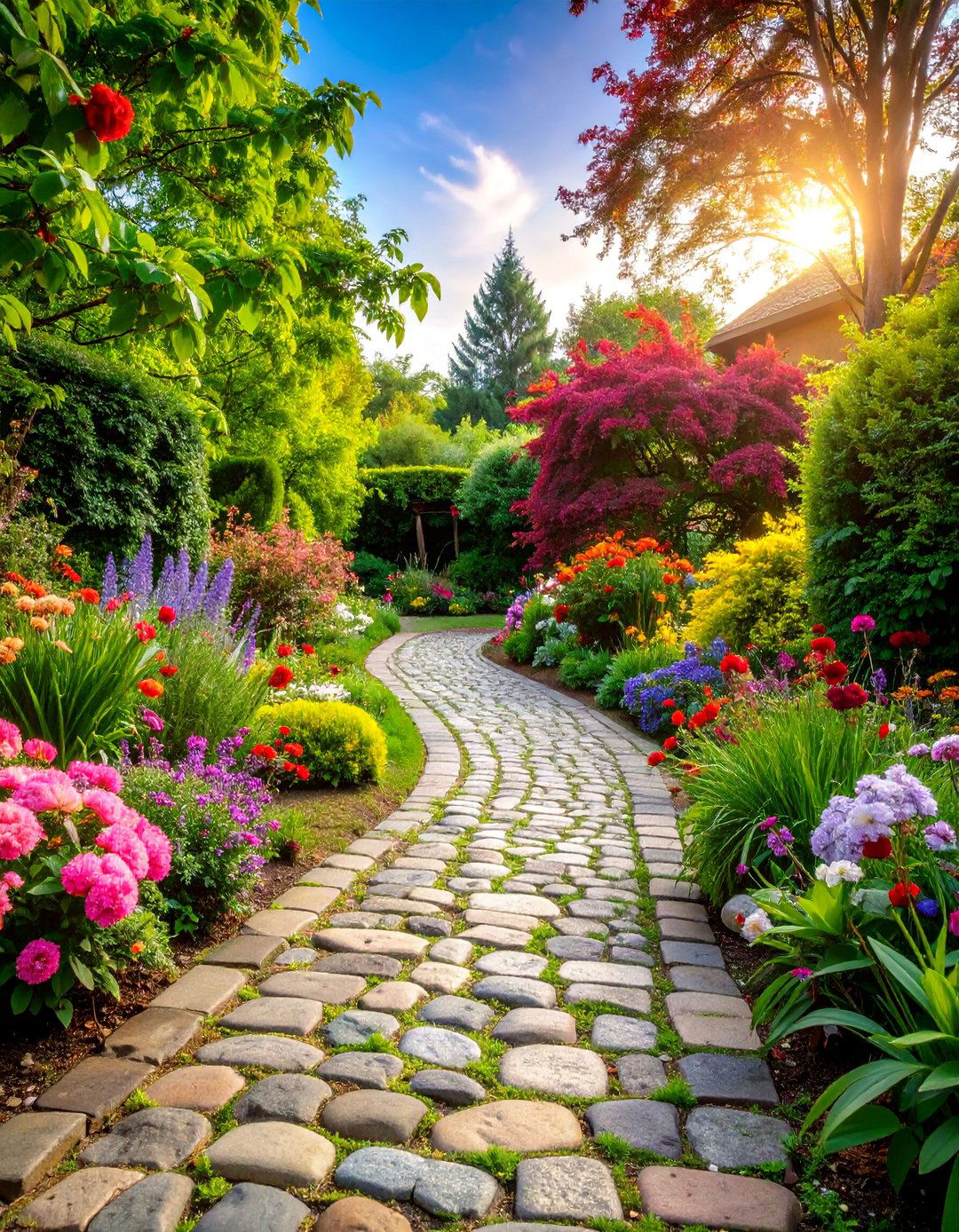
Cobblestone walkways evoke old-world charm with naturally rounded stones that create distinctive, textured surfaces perfect for historic or cottage-style landscapes. These extremely durable stones withstand centuries of foot traffic while developing beautiful patina over time. Modern cobblestone installation utilizes flatter-topped varieties for improved walking comfort while maintaining traditional aesthetics. Proper sand and gravel base preparation ensures stable, permeable surfaces that handle freeze-thaw cycles effectively. Natural spacing between stones allows water infiltration while creating opportunities for moss or small plant growth. The irregular surfaces provide excellent traction in wet conditions while adding significant visual interest and character to outdoor spaces.
9. Mixed Stone Mosaic Path
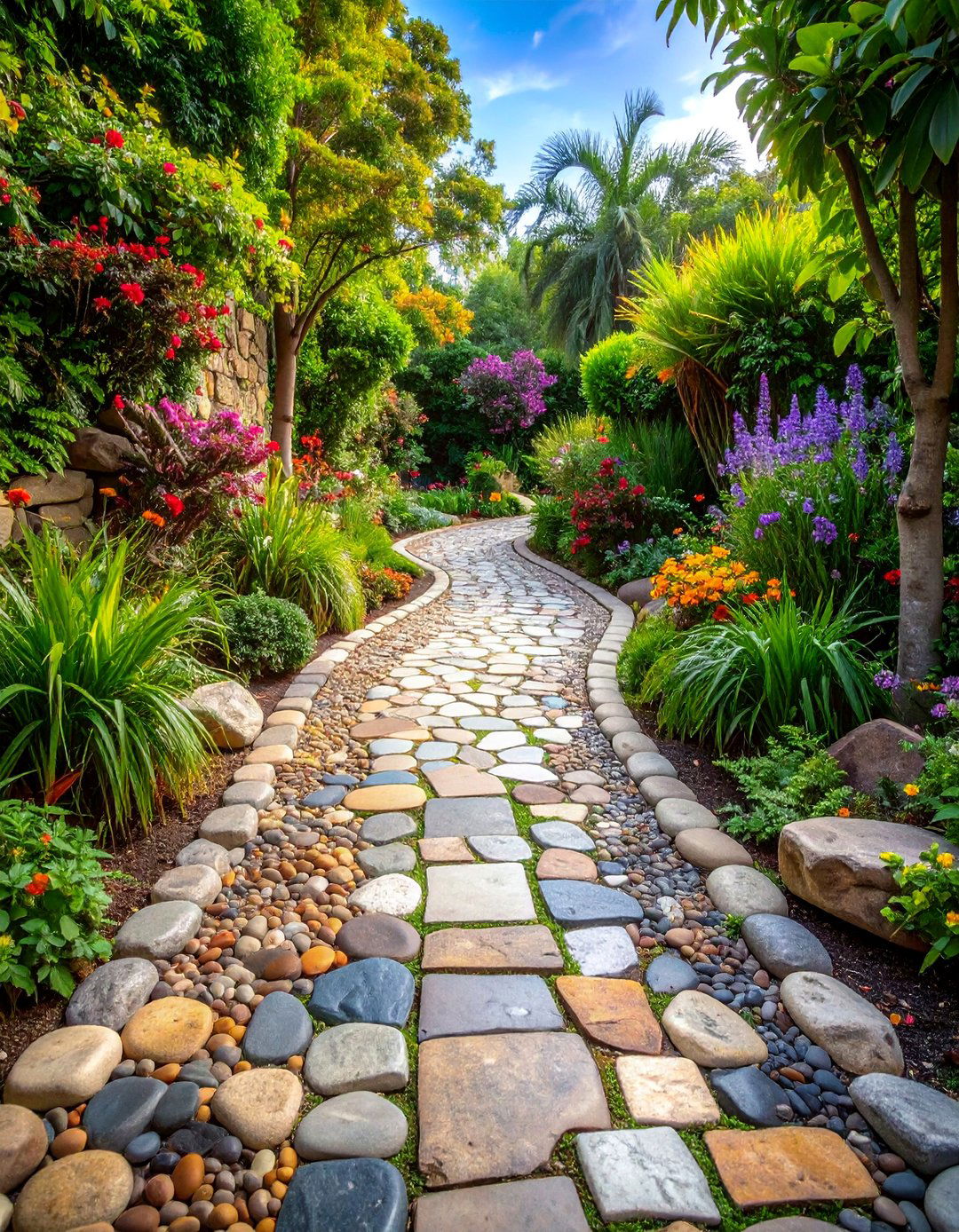
Mixed stone mosaic pathways combine various natural materials including flagstone, river rock, and crushed stone to create artistic, textured surfaces with exceptional visual appeal. This design approach allows creative expression while utilizing locally available materials for cost-effective installations. Different stone sizes and colors create dynamic patterns that guide foot traffic while providing opportunities for personalized design elements. Installation requires careful planning to ensure comfortable walking surfaces and proper drainage throughout the varied materials. The diverse textures and colors create changing visual experiences as lighting conditions change throughout the day. Regular maintenance involves minimal intervention as the mixed materials settle naturally into harmonious arrangements.
10. Pine Bark Nugget Trail

Pine bark nugget trails offer aromatic, natural pathways with rustic appeal and excellent water absorption properties that benefit surrounding vegetation. These larger bark pieces provide textured walking surfaces while creating distinctive woodland aesthetics. Installation involves proper depth application over landscape fabric to prevent weed growth while allowing natural decomposition processes. The organic material gradually breaks down to enrich soil while requiring periodic replenishment to maintain path integrity. Pine bark naturally resists pest issues while providing cushioned surfaces comfortable for extended walking. The warm brown colors complement most landscape palettes while the natural fragrance enhances outdoor experiences, particularly in shaded garden areas.
11. Sandstone Slab Walkway
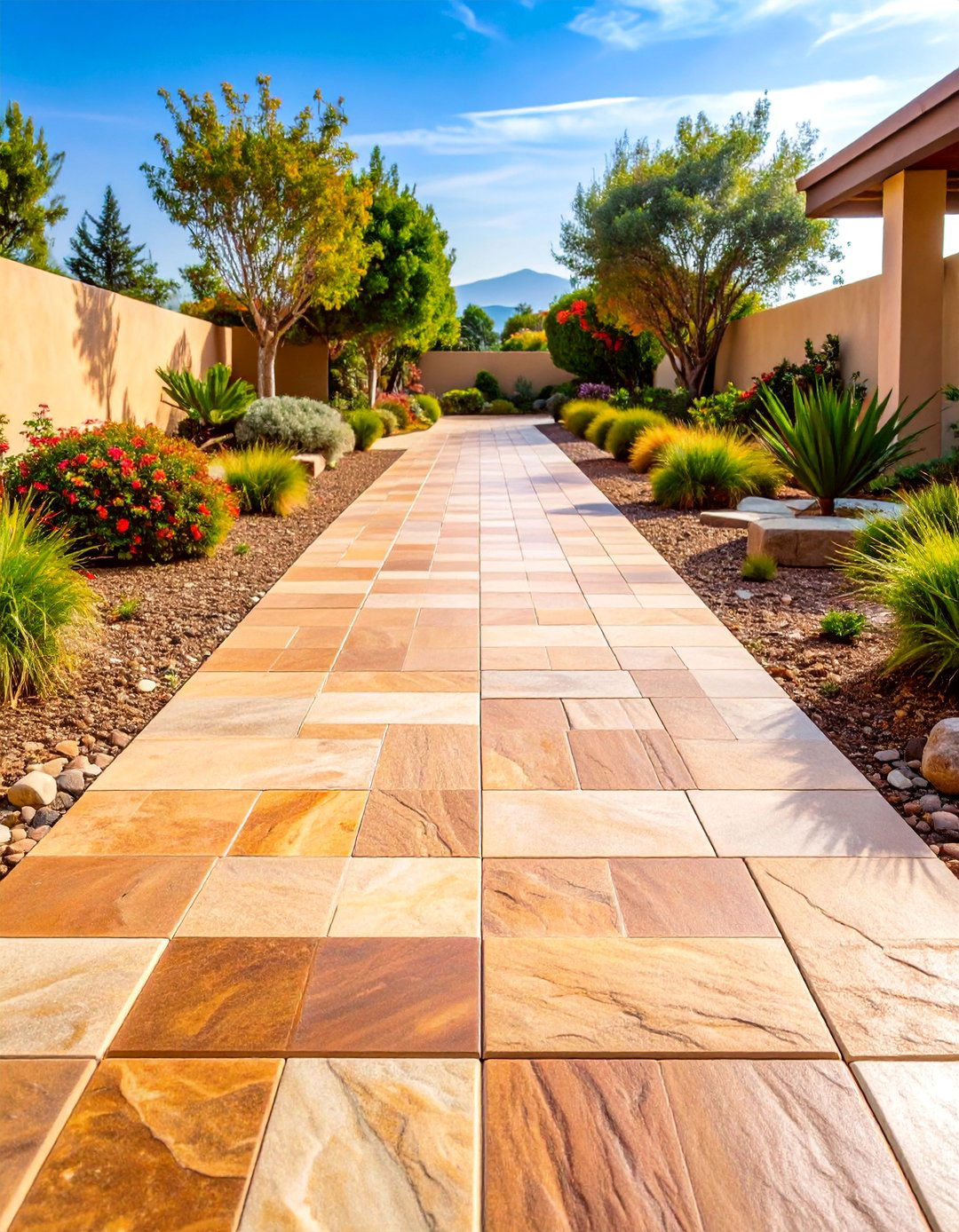
Sandstone slab walkways provide elegant, contemporary aesthetics with warm color palettes and naturally textured surfaces that resist weathering beautifully. These cut stone pieces offer consistent dimensions for formal installations while maintaining natural stone character. Various sandstone types including buff, gray, and red varieties provide color options to coordinate with architectural elements and landscape themes. Proper installation on sand bases ensures level surfaces while allowing for natural drainage and slight movement during seasonal changes. The fine-grained texture provides excellent traction while the material ages gracefully with minimal maintenance requirements. Sandstone's natural beauty improves over time as weathering creates subtle color variations and surface patina.
12. Gravel and Grass Combination Path
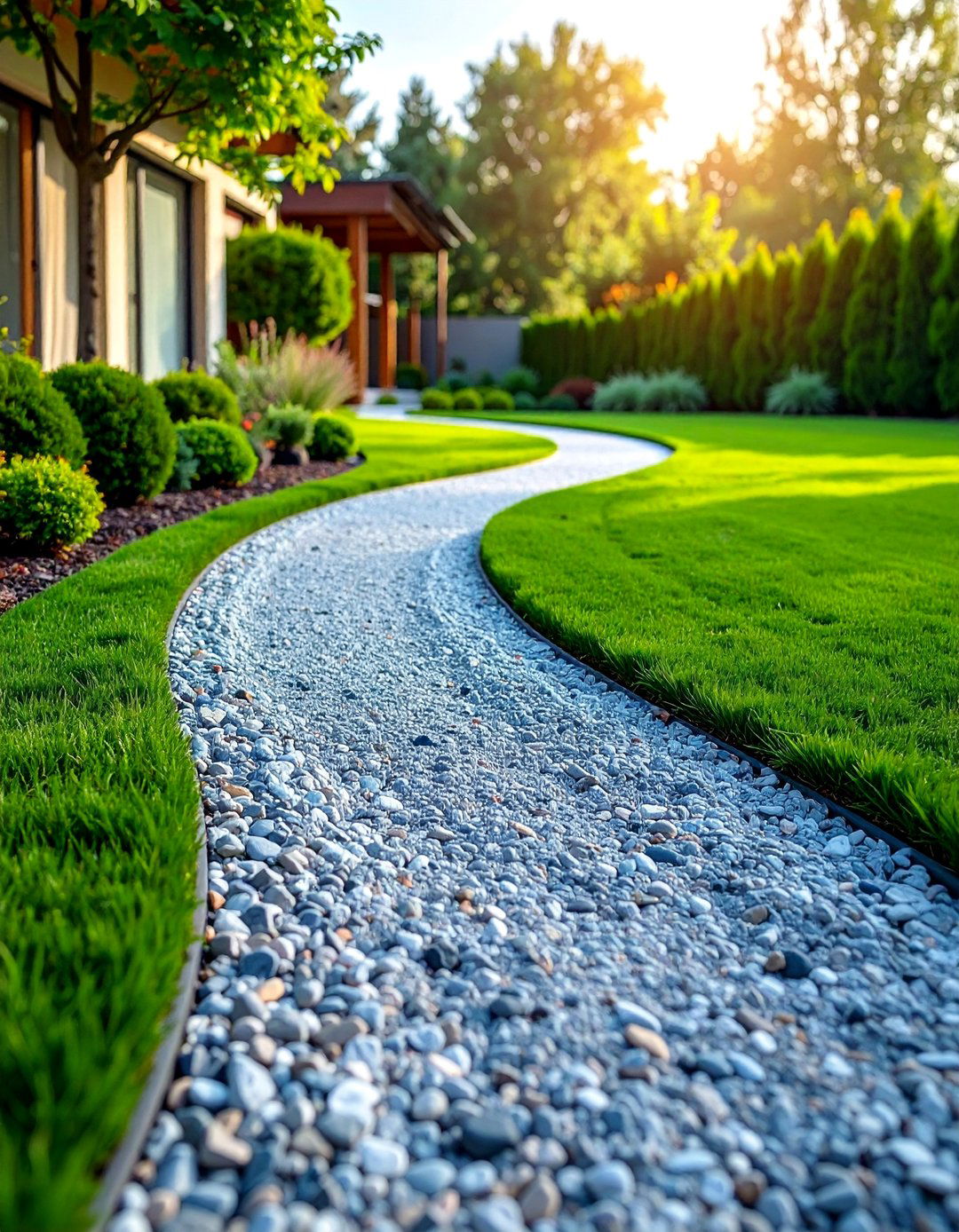
Gravel and grass combination paths create striking visual contrasts while providing practical, permeable walkway solutions that integrate seamlessly with landscape environments. This design alternates gravel strips with grass sections to balance hard and soft surfaces for comfortable walking experiences. Installation requires careful grade preparation and edging to maintain clean lines between materials while ensuring proper drainage throughout. The grass sections provide cooling effects and visual softness while gravel areas offer all-weather accessibility and reduced maintenance. Regular care involves grass maintenance and occasional gravel replenishment to preserve the distinctive pattern. This approach works particularly well in contemporary landscapes and areas requiring sustainable drainage solutions.
13. Cedar Plank Boardwalk
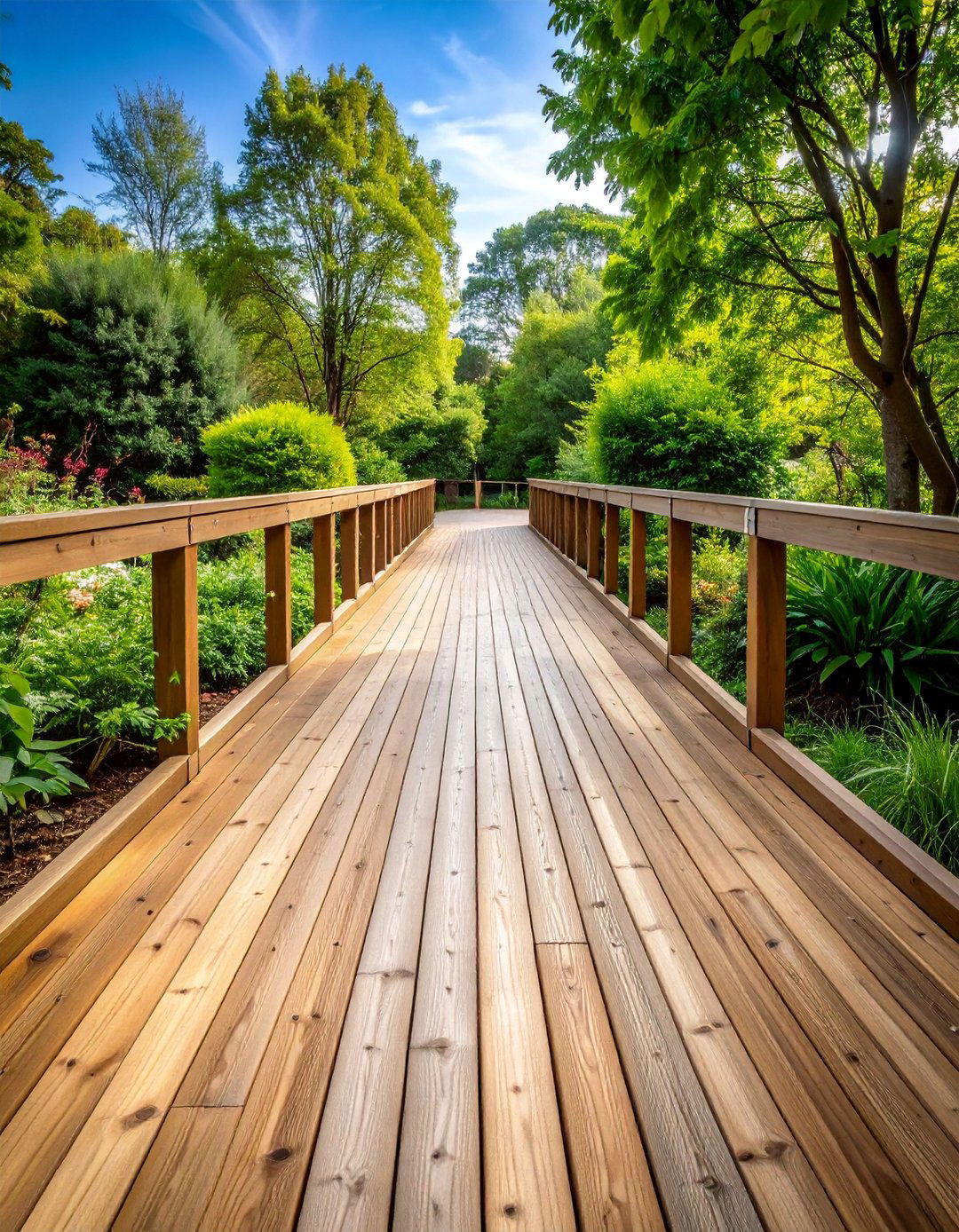
Cedar plank boardwalks bring natural warmth and elevated elegance to outdoor pathways while providing excellent moisture resistance and longevity in various weather conditions. The natural oils in cedar prevent rot and insect damage while developing attractive silver-gray patina over time. Installation involves proper framing and drainage considerations to ensure stable, long-lasting structures that handle seasonal movement. Cedar's lightweight properties simplify construction while the natural grain patterns create beautiful surface textures. Regular maintenance involves periodic cleaning and optional sealing to preserve appearance, though cedar weathers gracefully when left natural. The elevated design works exceptionally well in wet areas, sloped terrain, and locations requiring protection of underlying vegetation.
14. Decomposed Granite Pathway
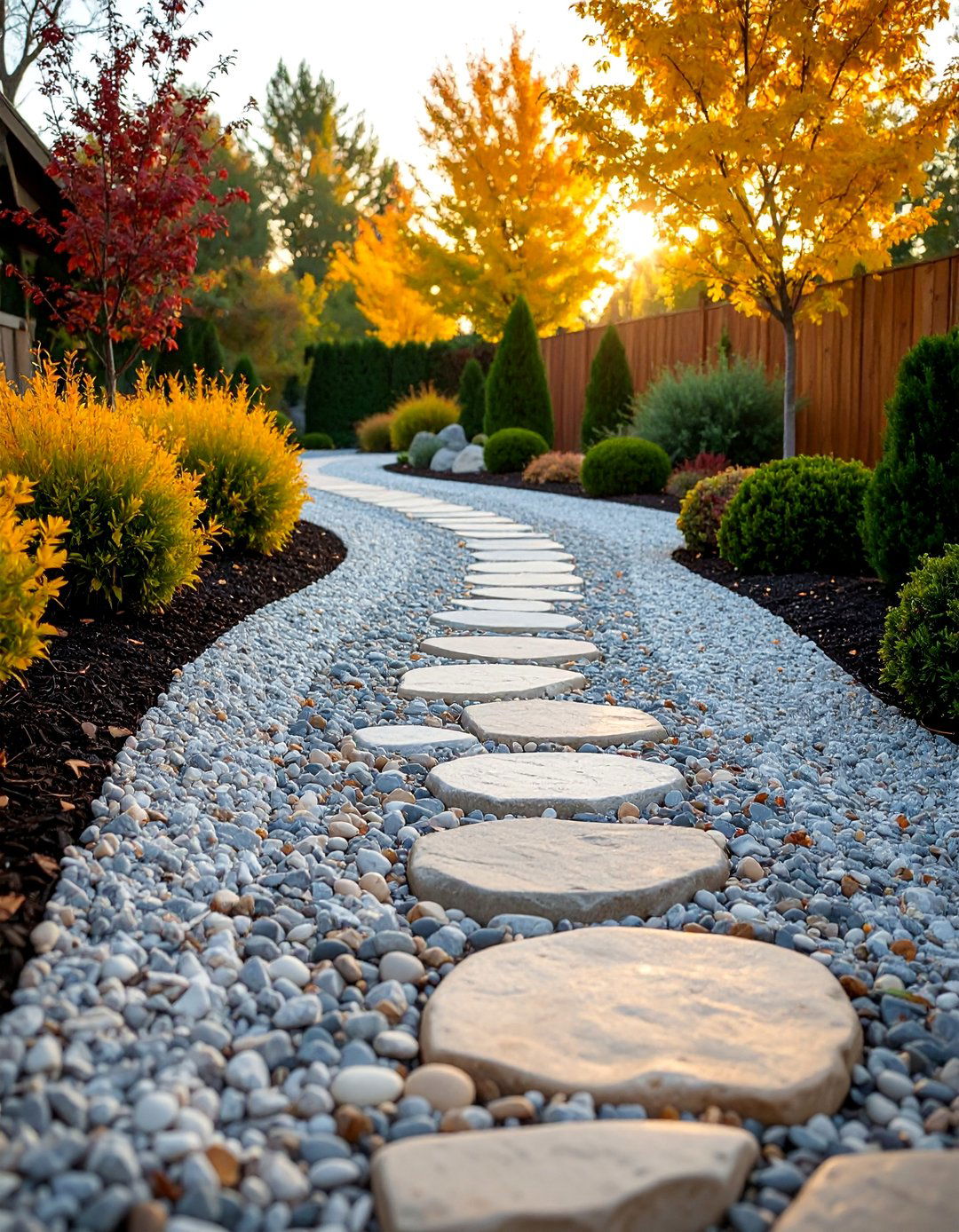
Decomposed granite pathways offer stable, natural surfaces with fine textures that compact well while maintaining excellent drainage and dust-free characteristics. This material provides contemporary aesthetics with earthy colors ranging from gold to gray that complement modern landscape designs. Proper installation includes moisture application during compaction to achieve optimal density and stability for foot traffic. The smooth surface allows comfortable walking while the natural composition supports sustainable landscaping practices. Periodic maintenance involves minor releveling and occasional additions to maintain optimal surface conditions. Decomposed granite works exceptionally well in arid climates and drought-tolerant landscapes while providing wheelchair accessibility and low environmental impact.
15. Slate Stepping Stone Design

Slate stepping stone designs showcase sophisticated natural materials with rich colors and smooth textures that create refined walkway aesthetics suitable for contemporary landscapes. These metamorphic stones offer exceptional durability and slip-resistant surfaces while displaying beautiful natural color variations. Installation allows creative spacing and arrangement patterns to accommodate landscape features and traffic flow requirements. Slate's natural cleavage properties create consistent thickness while the dense composition resists weathering and maintains appearance over decades. Various colors including blue-gray, green, and purple provide design flexibility to coordinate with architectural elements. The non-porous surface requires minimal maintenance while developing subtle patina that enhances natural beauty over time.
16. Natural Log Round Path
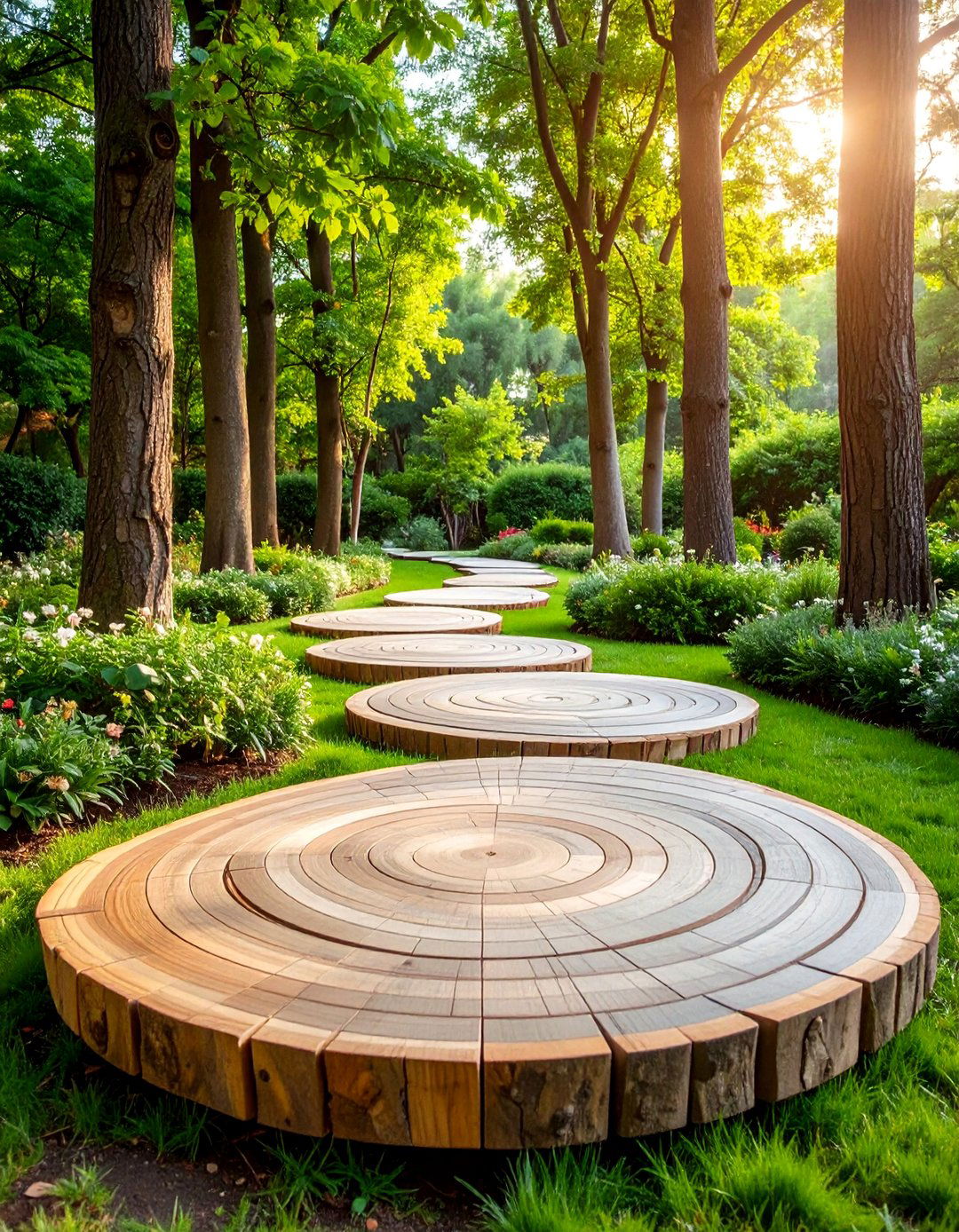
Natural log round paths create rustic, woodland aesthetics using cross-sections of fallen trees to form unique stepping surfaces that celebrate natural materials and sustainable practices. These irregular, organic shapes provide textured walking experiences while showcasing natural wood grain patterns and growth rings. Installation involves leveling sand bases and careful placement to ensure stable surfaces despite natural variations in size and thickness. Different wood species offer varying colors, textures, and durability characteristics to suit specific climate conditions. Regular maintenance includes periodic releveling and replacement of deteriorated sections as wood naturally weathers and decomposes. This approach works exceptionally well in forest settings, naturalistic gardens, and areas emphasizing environmental consciousness.
17. Moss and Stone Walkway

Moss and stone walkways combine natural materials to create magical, fairy-tale aesthetics with soft, living carpets surrounding stable stone surfaces. This design encourages beneficial moss growth in shaded, moist areas while providing reliable foot placement on stone elements. Installation requires selecting appropriate microclimates and preparing surfaces that support moss establishment while ensuring proper stone stability. Various moss species offer different textures and growth patterns to create diverse visual effects throughout the pathway. Regular maintenance involves protecting moss during establishment and preventing excessive foot traffic on delicate areas. The living pathway evolves naturally over time, creating increasingly lush and enchanting walking experiences that celebrate the intersection of hardscape and nature.
18. Crushed Shell Walkway
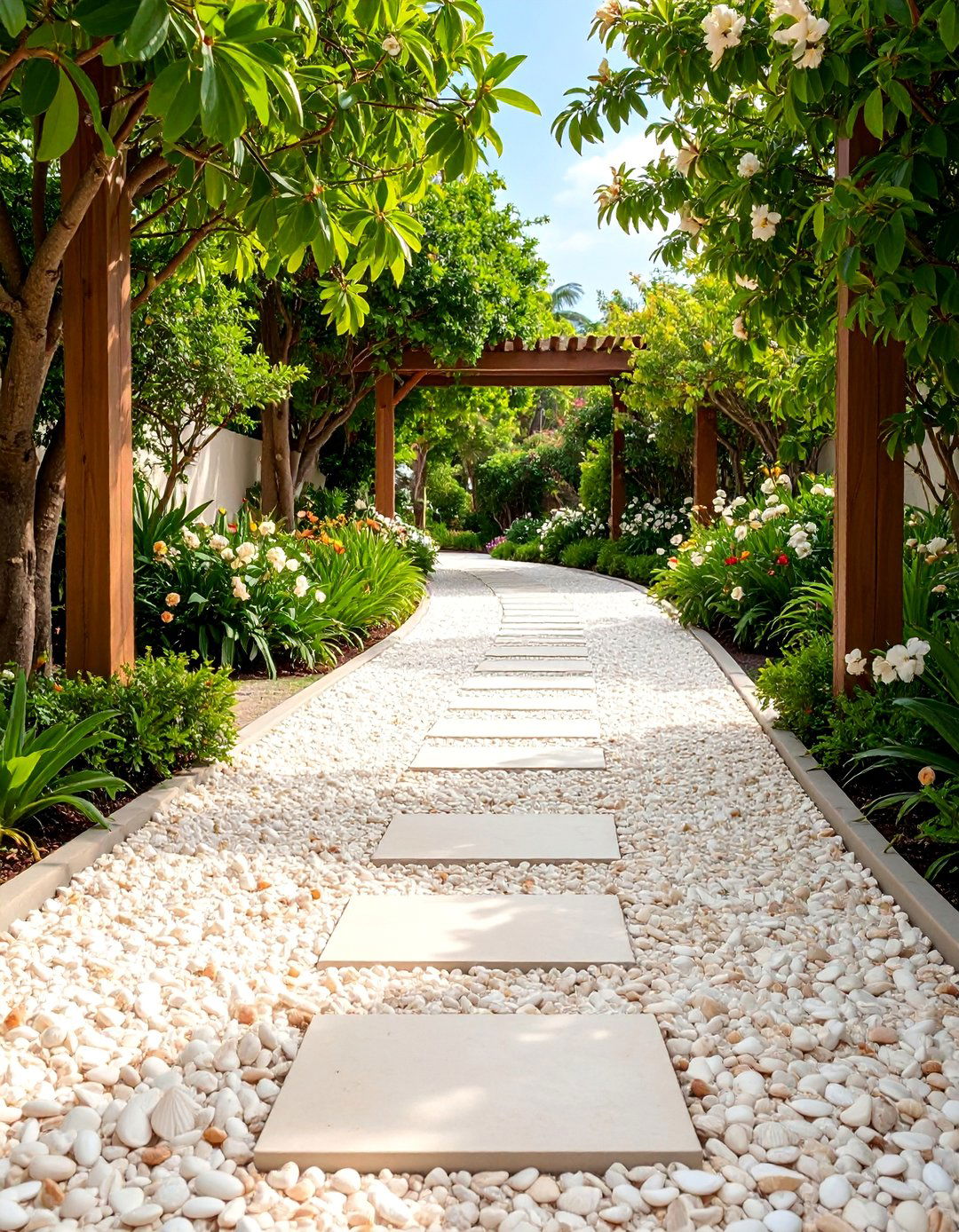
Crushed shell walkways provide coastal-inspired aesthetics with sustainable materials that offer excellent drainage and natural calcium enrichment for surrounding vegetation. These recycled seafood industry byproducts create unique, light-colored surfaces with interesting textures that reflect natural beach environments. Installation requires proper depth application and edging to maintain pathway integrity while allowing natural compaction over time. The alkaline properties benefit acid-loving plants while the porous structure supports excellent water infiltration. Regular maintenance involves occasional additions to replace scattered material and periodic raking to maintain smooth surfaces. This environmentally friendly option works particularly well in coastal gardens, seaside properties, and landscapes emphasizing sustainable material choices.
19. Fieldstone Natural Pathway

Fieldstone natural pathways utilize locally sourced stones with irregular shapes and surfaces to create authentic, regionally appropriate walkways that celebrate local geological characteristics. These unprocessed stones maintain natural weathering patterns and lichen growth that connect pathways directly to surrounding landscapes. Installation allows creative arrangement while ensuring stable walking surfaces despite irregular shapes and sizes. The rugged textures provide excellent traction while the varied colors and patterns create dynamic visual interest throughout the pathway. Minimal processing requirements reduce environmental impact while supporting local stone resources. Regular maintenance involves occasional releveling and vegetation management while preserving the natural character that makes fieldstone pathways uniquely suited to their geographic locations.
20. Recycled Concrete Stepping Stones

Recycled concrete stepping stones offer sustainable walkway solutions with customizable shapes and textures while diverting construction waste from landfills. These environmentally conscious materials can be formed into regular or irregular shapes to suit various design preferences and landscape styles. Installation provides opportunities for creative spacing and pattern development while ensuring stable, level surfaces for safe walking. The neutral colors complement most landscape palettes while the durable composition withstands weather extremes and heavy foot traffic. Surface treatments can create various textures from smooth to heavily textured for different aesthetic effects. Regular maintenance involves minimal intervention while the material ages gracefully, developing subtle patina and moss growth that enhances natural integration with garden environments.
21. Bamboo Plank Walkway
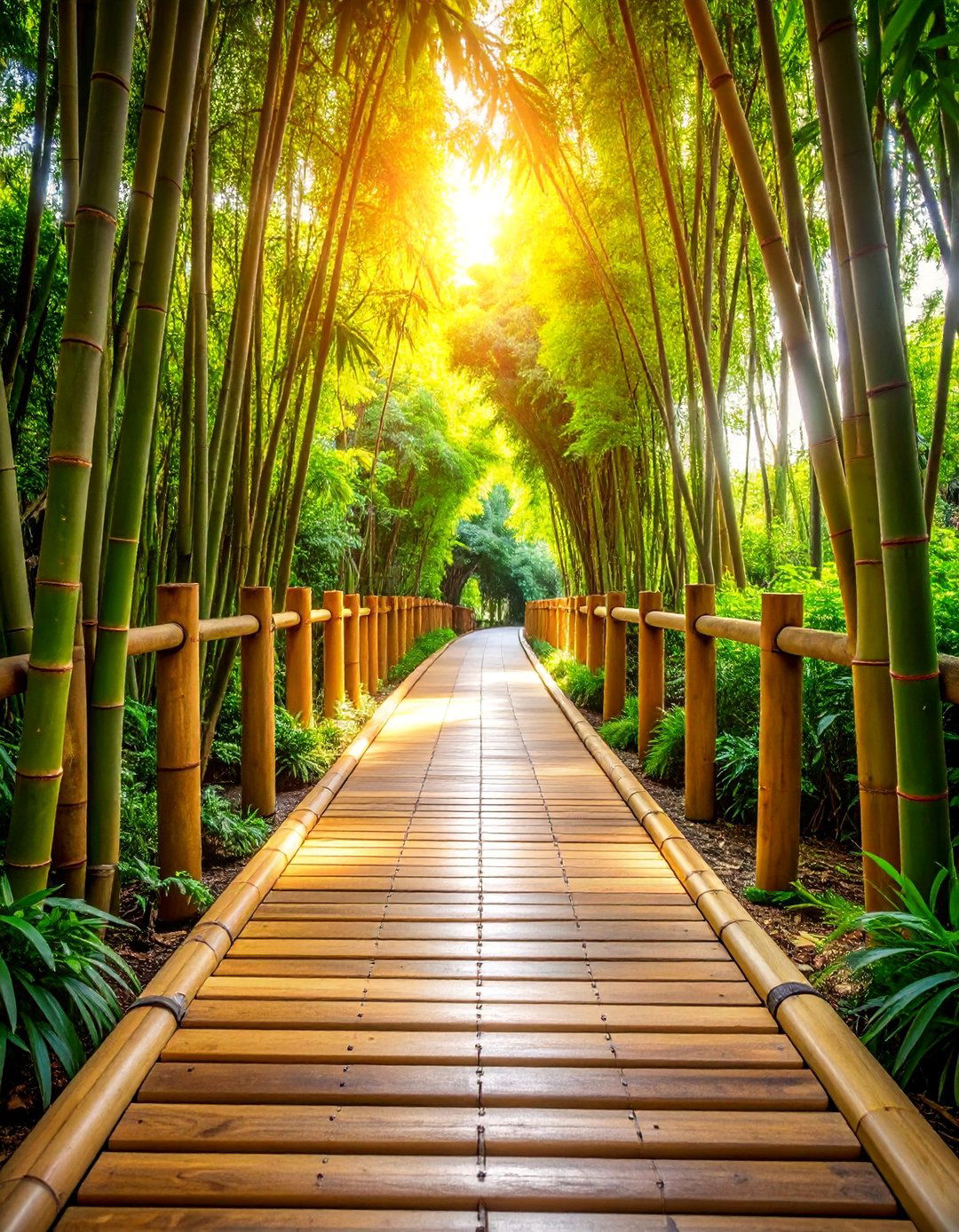
Bamboo plank walkways showcase rapidly renewable materials with distinctive aesthetics and exceptional strength-to-weight ratios that support sustainable landscape design practices. This fast-growing grass material offers natural flexibility and moisture resistance while developing attractive weathered appearances over time. Installation requires proper spacing and ventilation to prevent moisture accumulation while ensuring stable, comfortable walking surfaces. The natural segmented texture provides slip resistance while the warm colors complement various landscape styles from contemporary to tropical. Regular maintenance involves periodic cleaning and optional protective treatments to preserve appearance, though bamboo weathers naturally and gracefully. This environmentally conscious choice supports sustainable forestry practices while providing unique visual character unavailable with traditional wood materials.
22. Quartzite Natural Stone Path

Quartzite natural stone paths provide extremely durable surfaces with brilliant colors and crystalline textures that create stunning focal points in landscape designs. This metamorphic rock offers superior hardness and weather resistance while displaying natural sparkle and color variation. Installation showcases the material's natural beauty through careful arrangement that highlights color patterns and surface textures. Various quartzite types including white, pink, and gold varieties offer design flexibility to coordinate with architectural elements and garden themes. The non-slip surfaces provide excellent traction while requiring minimal maintenance beyond occasional cleaning. The exceptional durability ensures decades of service while the material's natural beauty improves over time as weathering reveals additional crystalline structures and color depths.
23. Pine Needle Mulch Trail
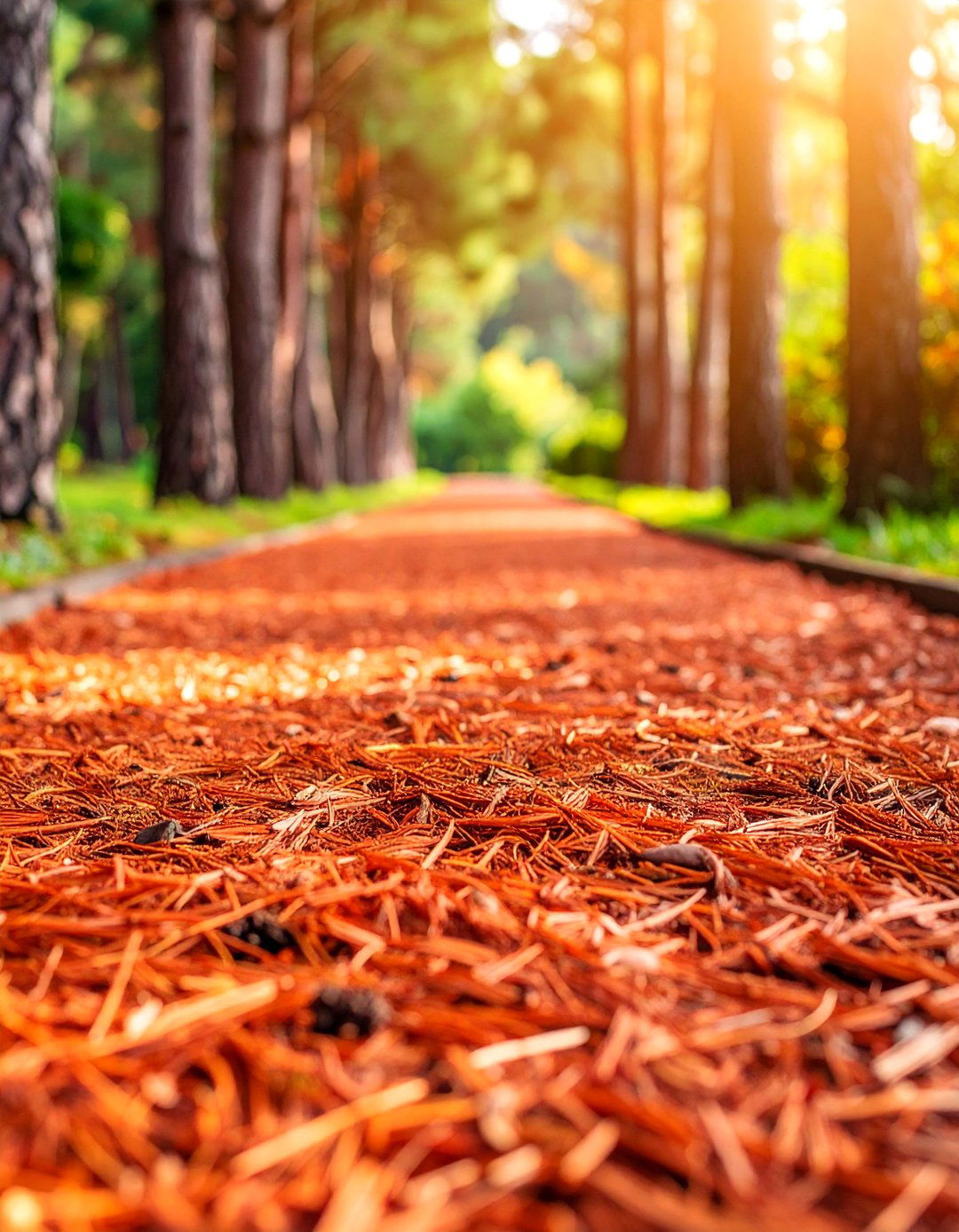
Pine needle mulch trails create aromatic, soft-textured pathways with natural acidifying properties that benefit surrounding vegetation while providing comfortable walking surfaces. These organic materials offer excellent water retention and weed suppression while developing rich, reddish-brown colors over time. Installation involves proper depth application to ensure adequate coverage while allowing natural compaction and decomposition processes. The acidic nature benefits plants preferring lower pH conditions while the natural oils provide pest resistance and distinctive fragrance. Regular maintenance involves periodic replenishment as materials decompose naturally while contributing organic matter to surrounding soil. This forest-inspired option works exceptionally well in woodland gardens, shade areas, and landscapes emphasizing natural material cycles.
24. Granite Block Walkway

Granite block walkways provide exceptional durability and sophisticated aesthetics with polished or natural finishes that create formal or rustic appearances depending on treatment choices. These igneous rock materials offer superior weather resistance and load-bearing capacity while maintaining consistent dimensions for precise installation. Various granite colors including gray, pink, and black provide design options to coordinate with architectural elements and landscape themes. Proper installation ensures level surfaces while allowing for thermal expansion and natural settling over time. The dense composition resists staining and wear while requiring minimal maintenance beyond occasional cleaning. The investment in granite materials provides decades of service while the timeless appearance enhances property values and creates lasting landscape features.
25. Mixed Mulch and Stone Design
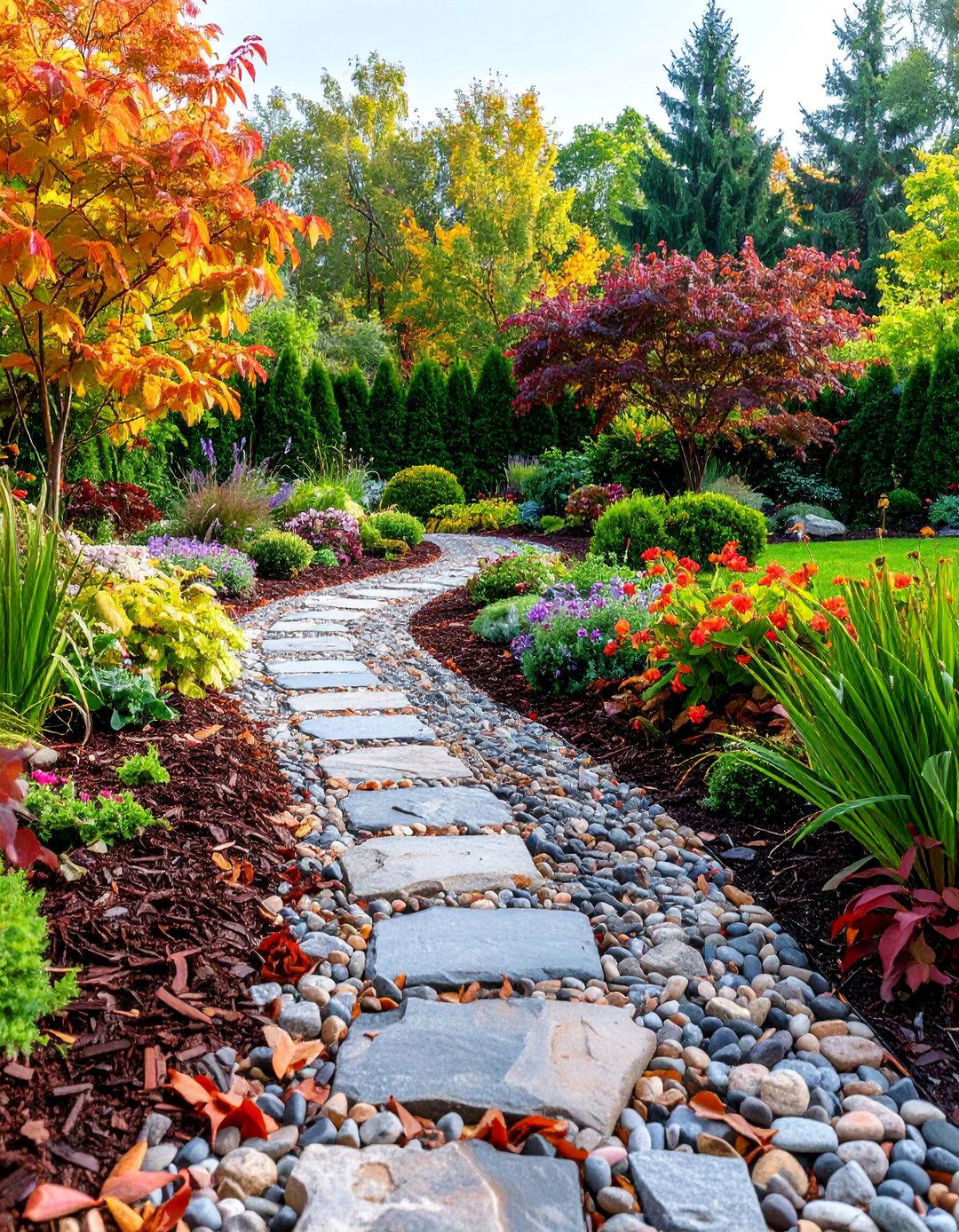
Mixed mulch and stone designs combine organic and mineral materials to create textured, naturalistic pathways that change seasonally while providing year-round accessibility and visual interest. This approach balances hard and soft elements through strategic placement of stone stepping areas within organic mulch surfaces. Installation allows creative expression while ensuring practical foot placement and proper drainage throughout varying materials. The organic components provide soil enrichment and seasonal color changes while stone elements offer permanent structure and all-weather access. Regular maintenance involves periodic mulch replenishment and stone cleaning while allowing natural integration processes to develop over time. This dynamic approach celebrates seasonal changes while providing functional walkway solutions that evolve naturally within garden environments.
Conclusion:
Natural walkway designs offer unlimited possibilities for creating functional, beautiful pathways that enhance outdoor spaces while supporting environmental sustainability. From simple gravel paths to sophisticated stone installations, these materials provide durable solutions that improve over time through natural weathering and integration with surrounding landscapes. Proper material selection based on climate, usage patterns, and aesthetic preferences ensures successful installations that serve both practical and visual functions. The investment in natural walkway materials creates lasting value while supporting sustainable landscape practices and connecting outdoor spaces with natural beauty.


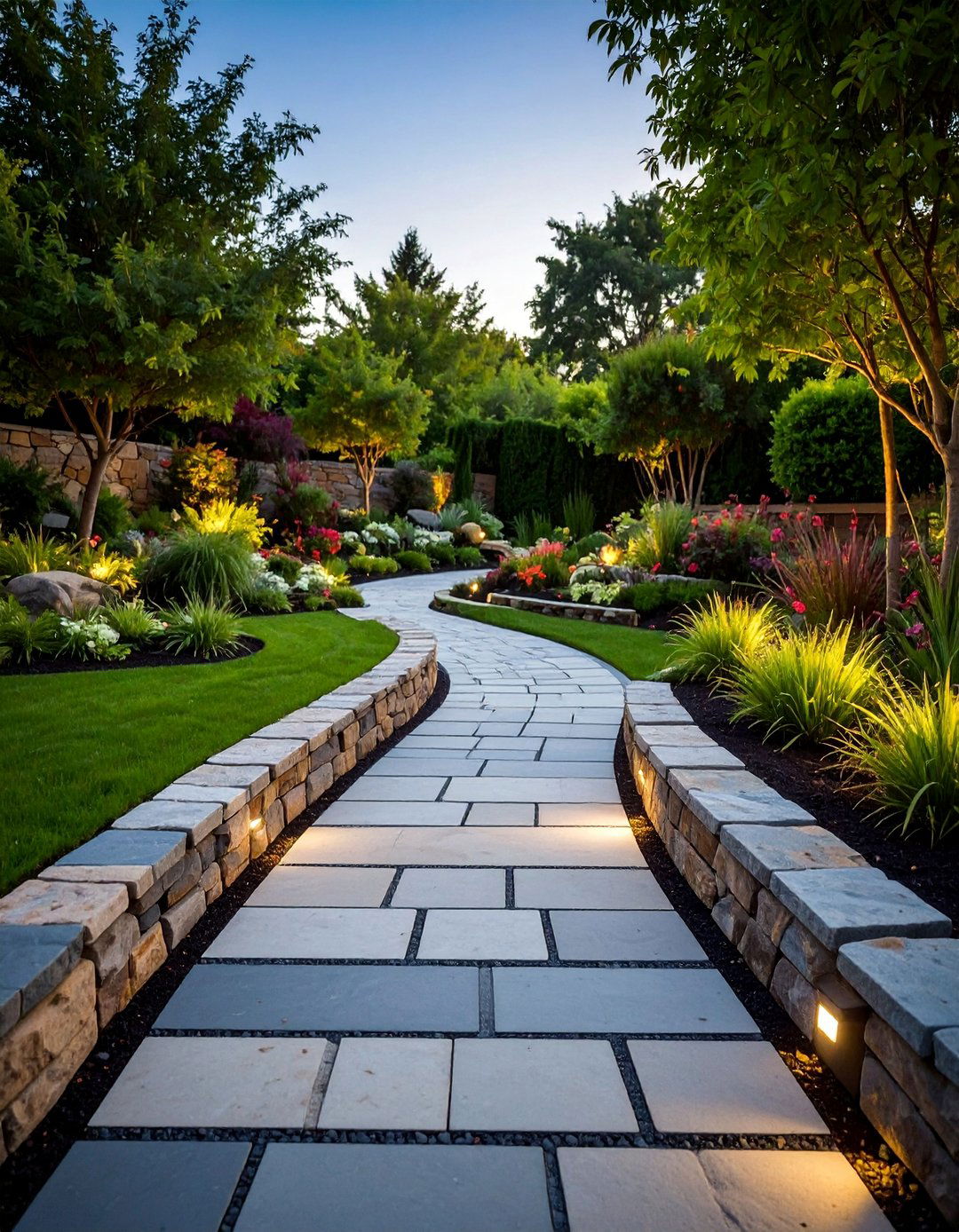


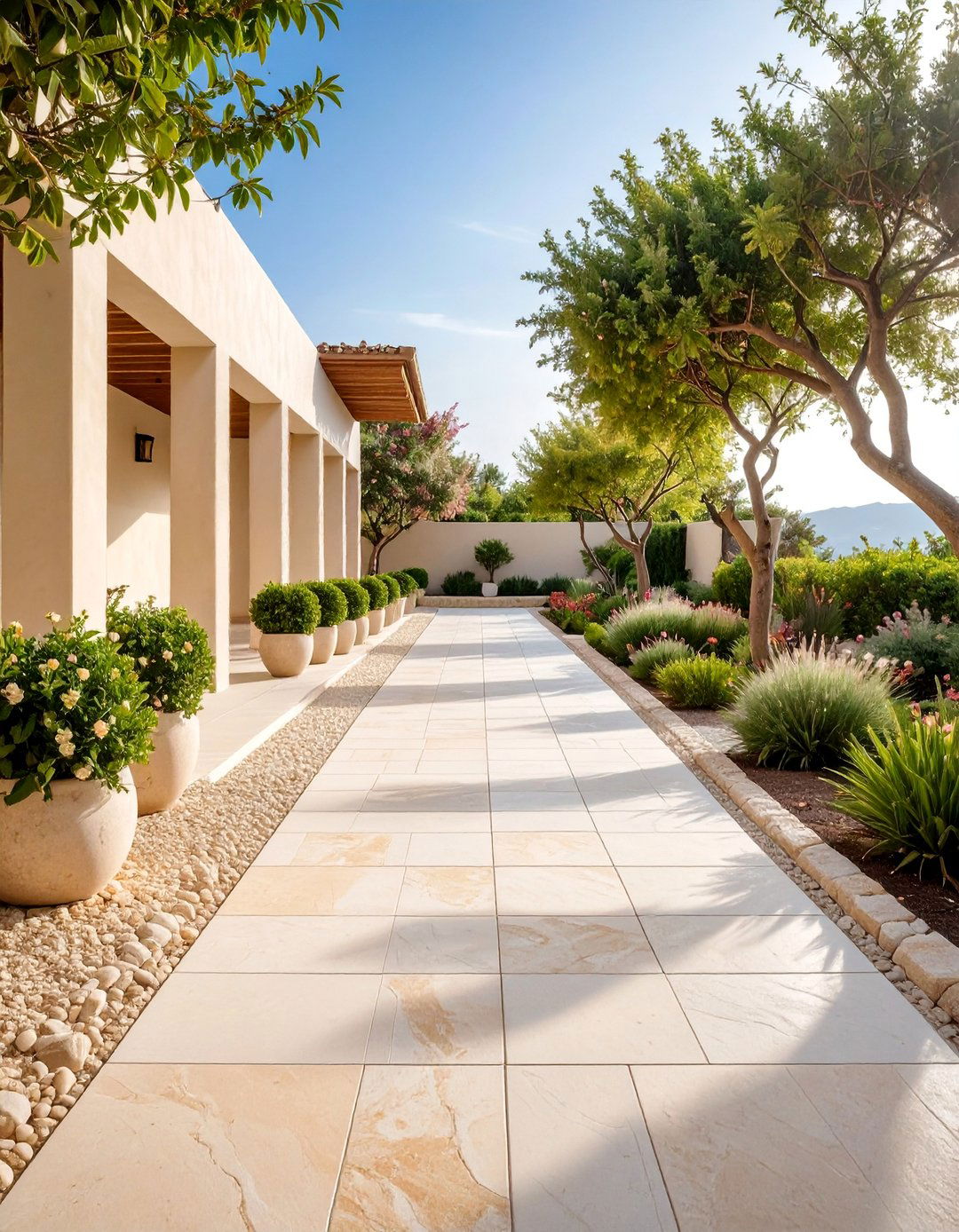
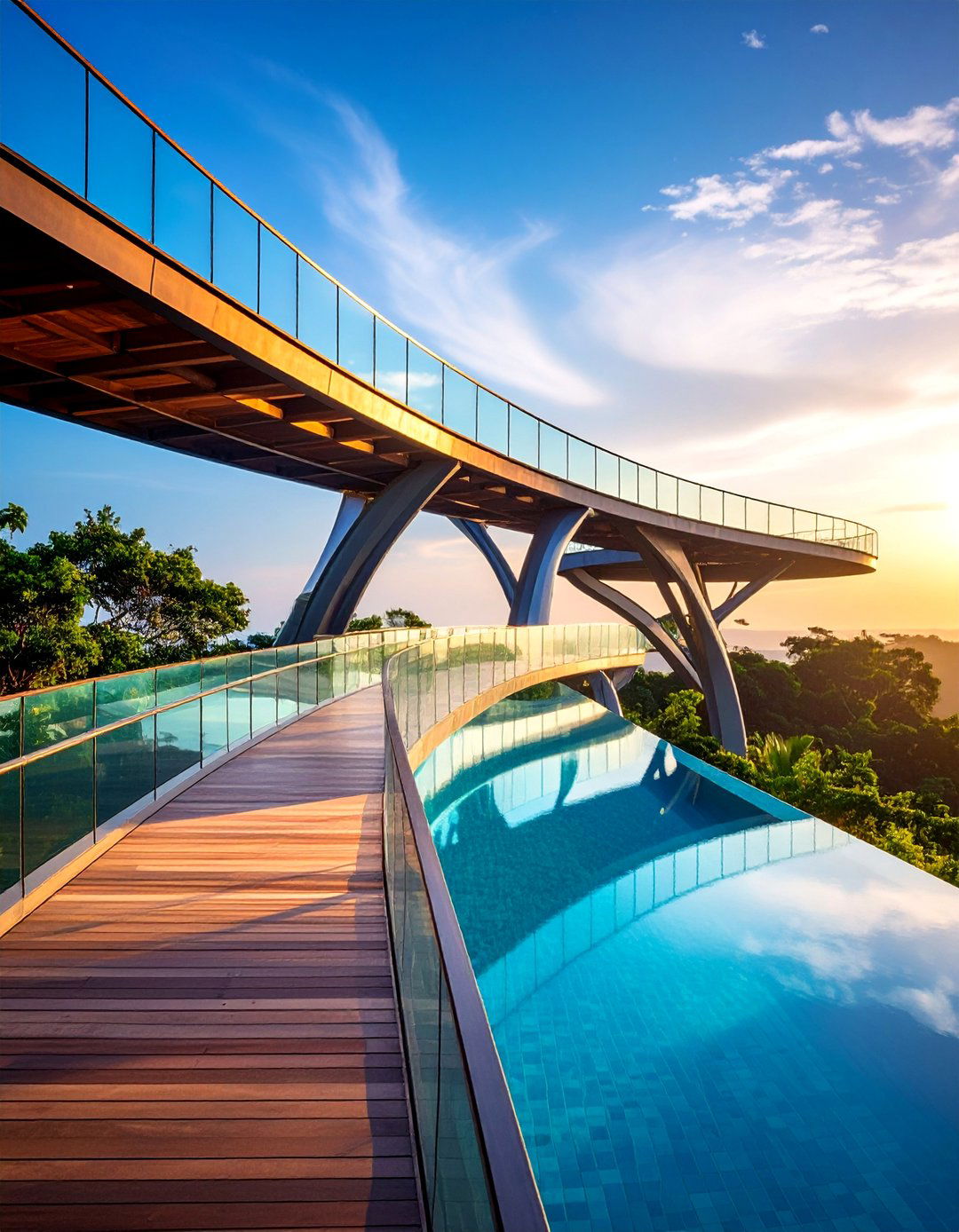
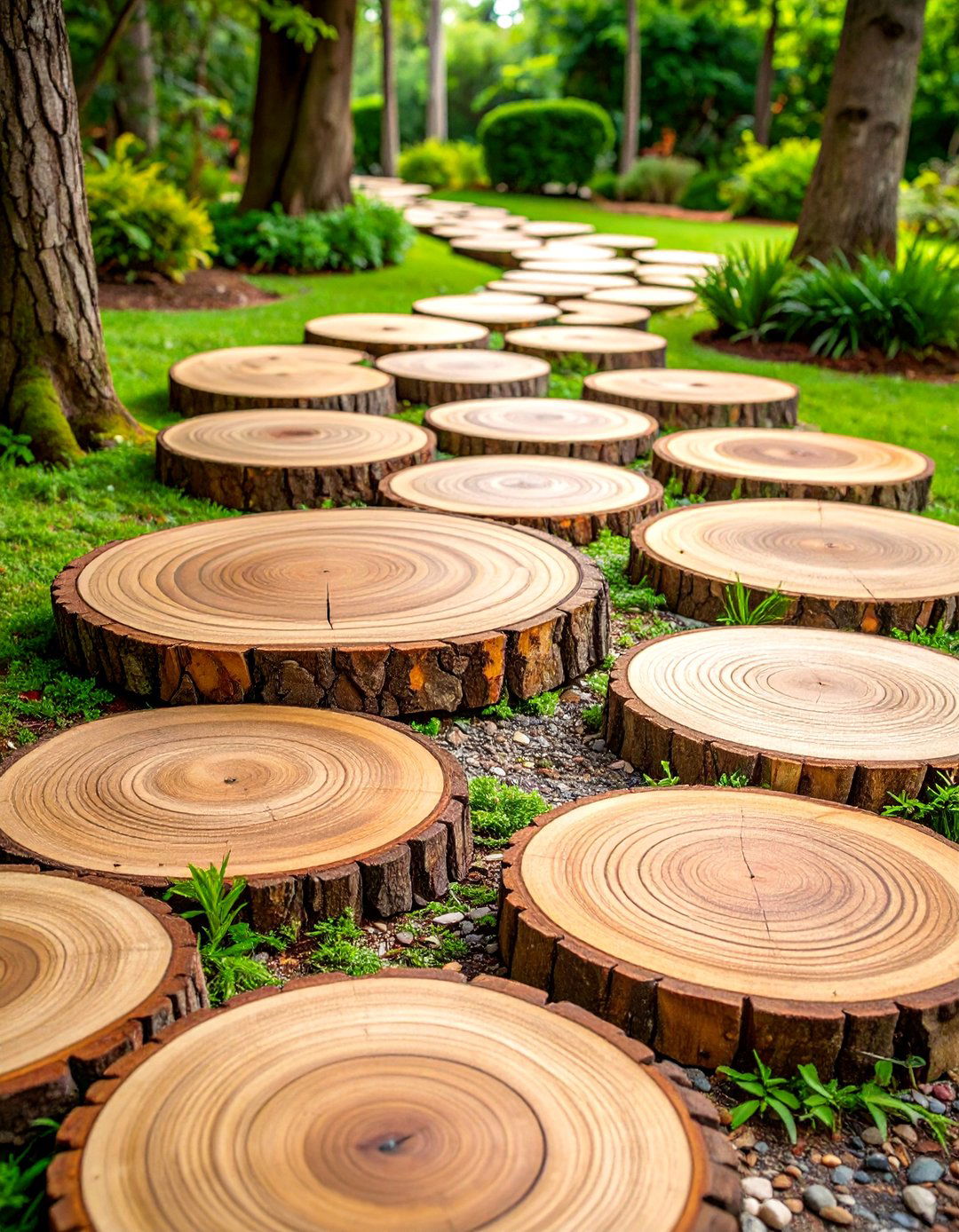


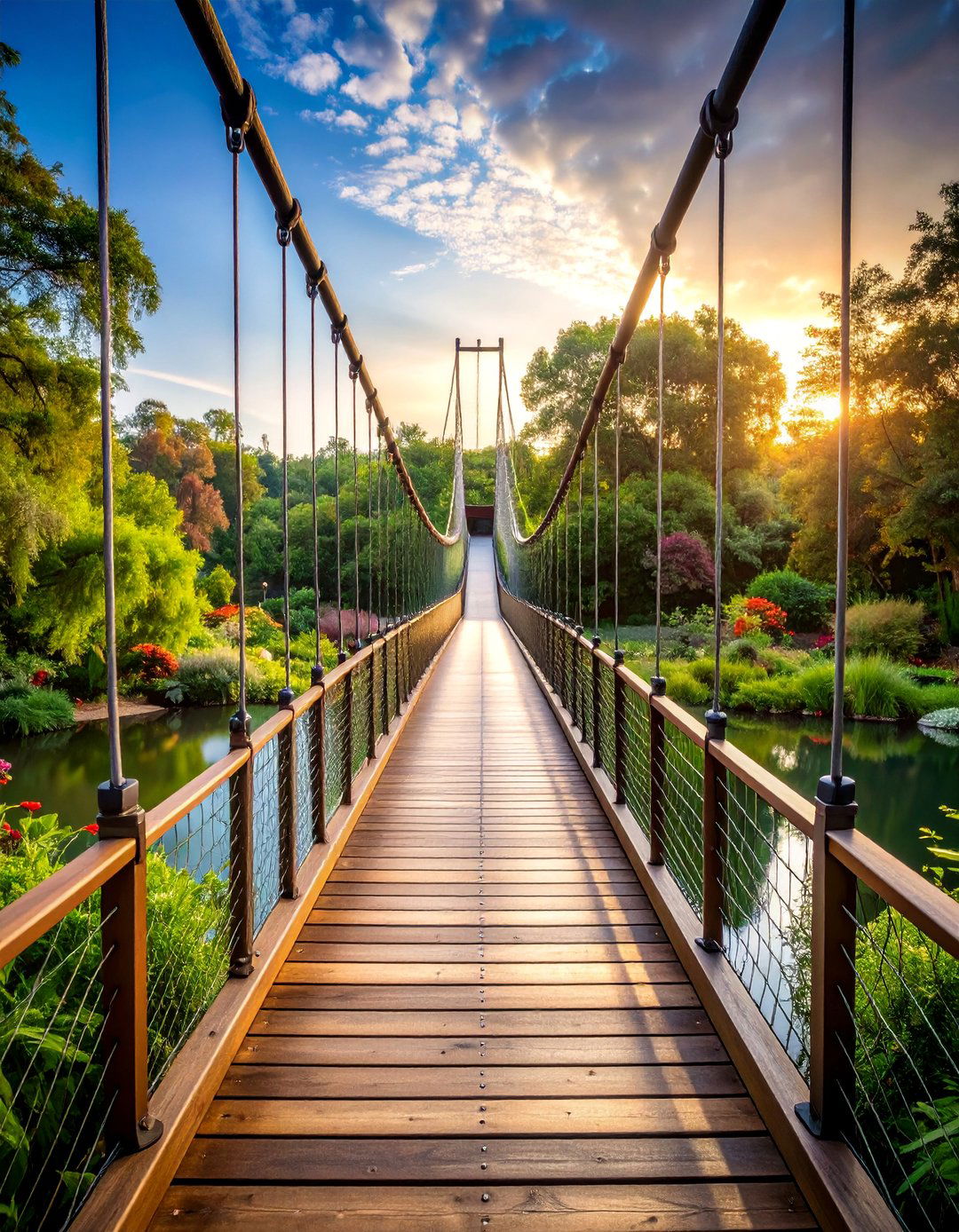


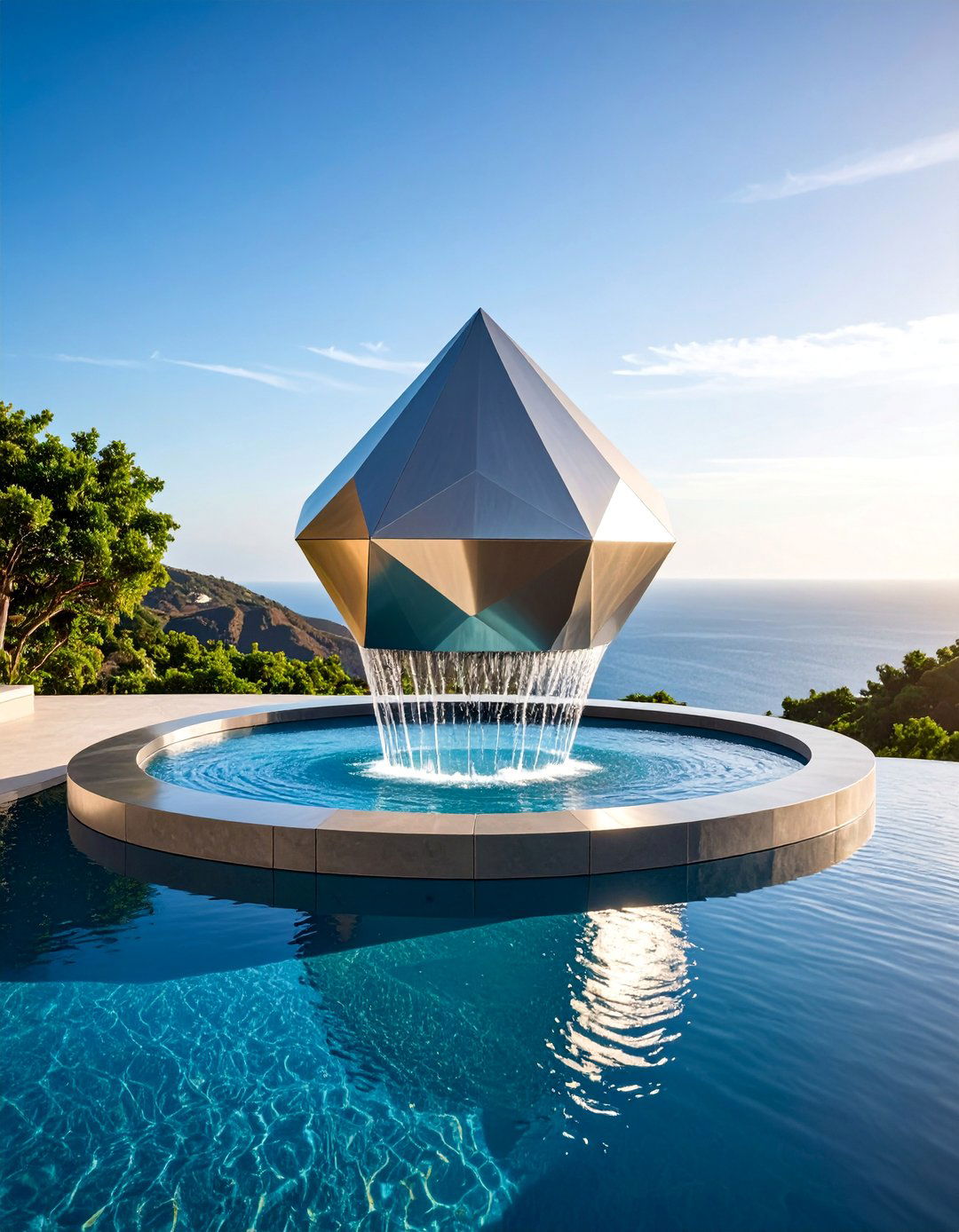


Leave a Reply